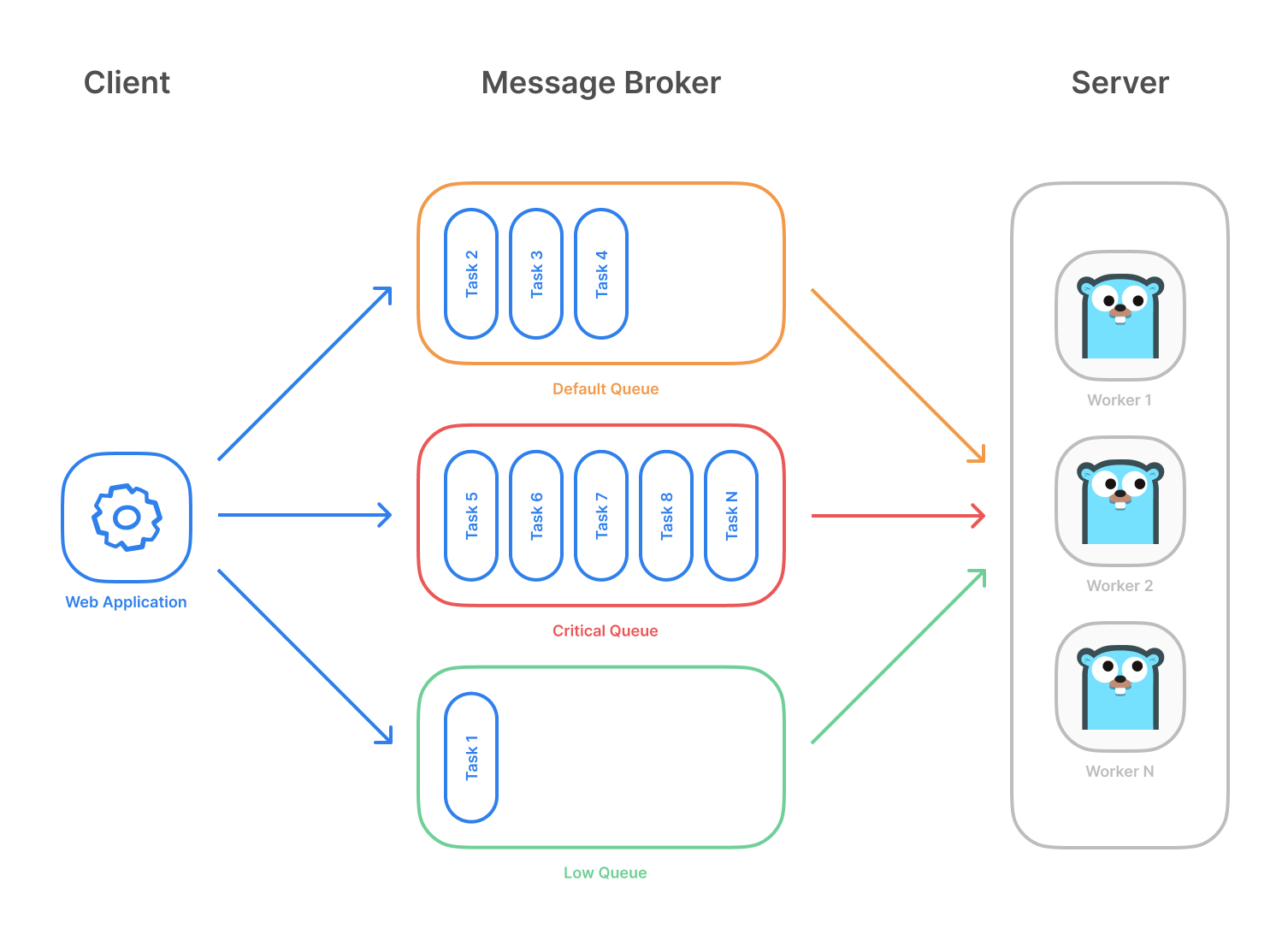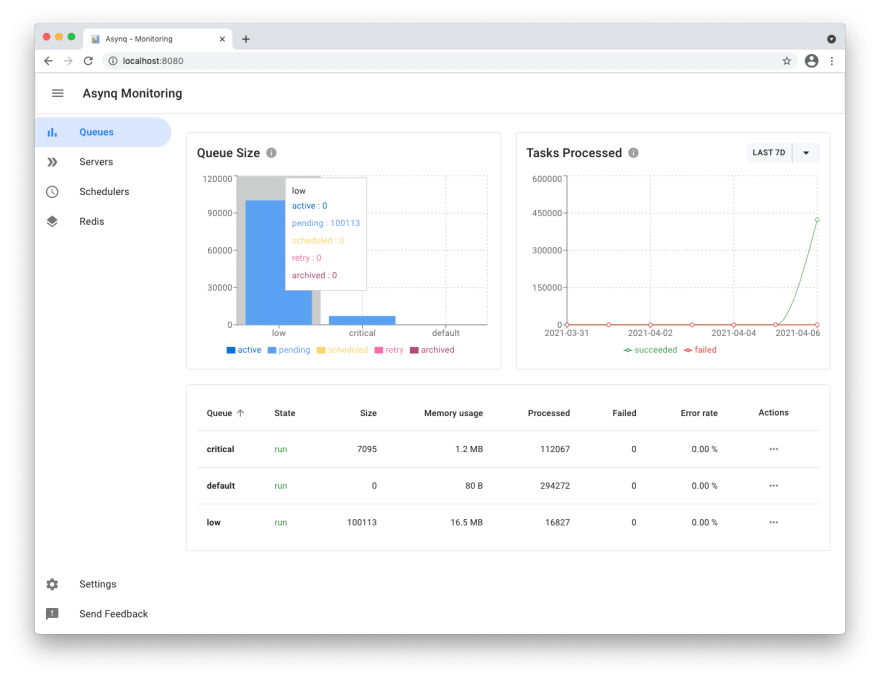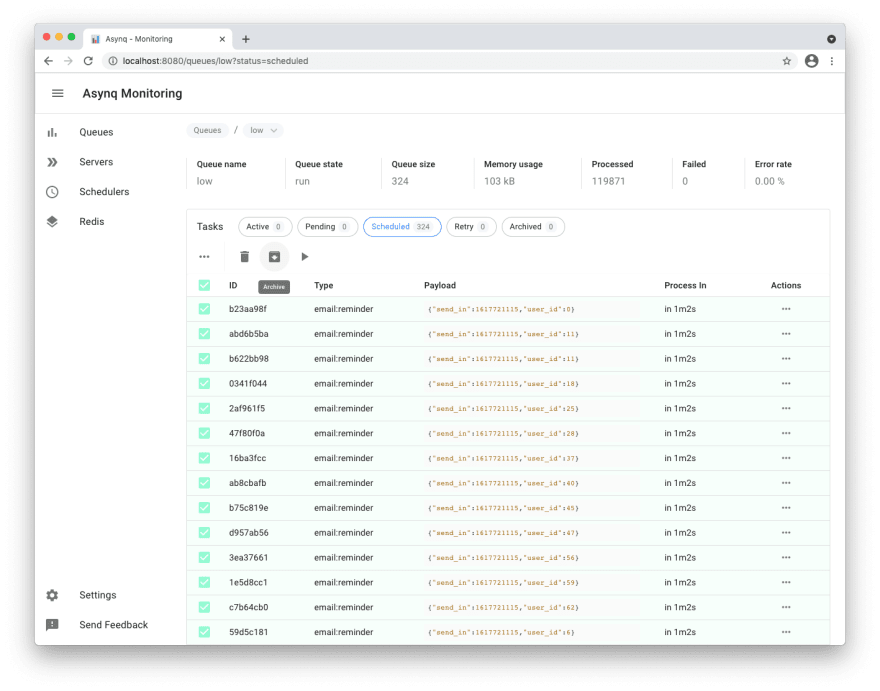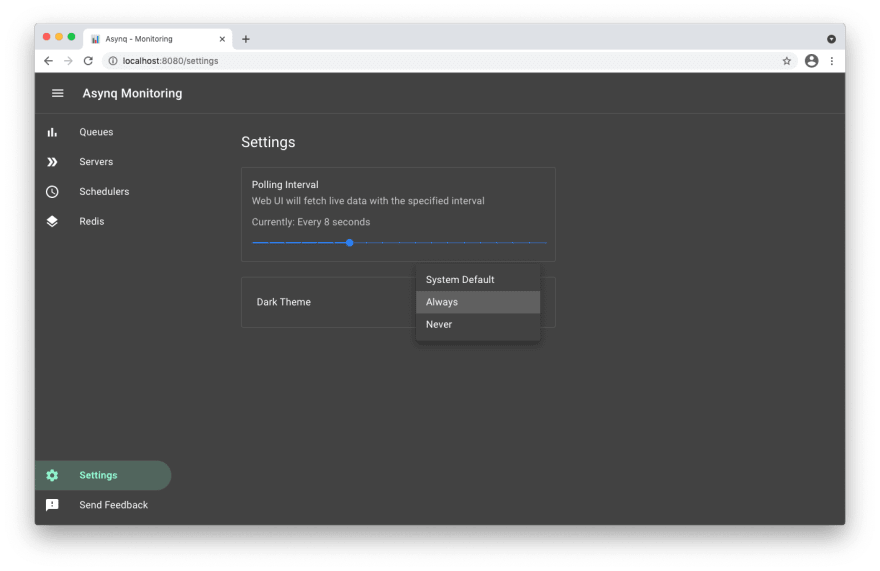mirror of
https://github.com/hibiken/asynq.git
synced 2024-11-14 11:31:18 +08:00
313 lines
12 KiB
Markdown
313 lines
12 KiB
Markdown
<img src="https://user-images.githubusercontent.com/11155743/114697792-ffbfa580-9d26-11eb-8e5b-33bef69476dc.png" alt="Asynq logo" width="360px" />
|
|
|
|
# Simple, reliable & efficient distributed task queue in Go
|
|
|
|
[](https://godoc.org/github.com/hibiken/asynq)
|
|
[](https://goreportcard.com/report/github.com/hibiken/asynq)
|
|

|
|
[](https://opensource.org/licenses/MIT)
|
|
[](https://gitter.im/go-asynq/community)
|
|
|
|
Asynq is a Go library for queueing tasks and processing them asynchronously with workers. It's backed by [Redis](https://redis.io/) and is designed to be scalable yet easy to get started.
|
|
|
|
Highlevel overview of how Asynq works:
|
|
|
|
- Client puts tasks on a queue
|
|
- Server pulls tasks off queues and starts a worker goroutine for each task
|
|
- Tasks are processed concurrently by multiple workers
|
|
|
|
Task queues are used as a mechanism to distribute work across multiple machines. A system can consist of multiple worker servers and brokers, giving way to high availability and horizontal scaling.
|
|
|
|
**Example use case**
|
|
|
|

|
|
|
|
## Features
|
|
|
|
- Guaranteed [at least one execution](https://www.cloudcomputingpatterns.org/at_least_once_delivery/) of a task
|
|
- Scheduling of tasks
|
|
- [Retries](https://github.com/hibiken/asynq/wiki/Task-Retry) of failed tasks
|
|
- Automatic recovery of tasks in the event of a worker crash
|
|
- [Weighted priority queues](https://github.com/hibiken/asynq/wiki/Queue-Priority#weighted-priority)
|
|
- [Strict priority queues](https://github.com/hibiken/asynq/wiki/Queue-Priority#strict-priority)
|
|
- Low latency to add a task since writes are fast in Redis
|
|
- De-duplication of tasks using [unique option](https://github.com/hibiken/asynq/wiki/Unique-Tasks)
|
|
- Allow [timeout and deadline per task](https://github.com/hibiken/asynq/wiki/Task-Timeout-and-Cancelation)
|
|
- Allow [aggregating group of tasks](https://github.com/hibiken/asynq/wiki/Task-aggregation) to batch multiple successive operations
|
|
- [Flexible handler interface with support for middlewares](https://github.com/hibiken/asynq/wiki/Handler-Deep-Dive)
|
|
- [Ability to pause queue](/tools/asynq/README.md#pause) to stop processing tasks from the queue
|
|
- [Periodic Tasks](https://github.com/hibiken/asynq/wiki/Periodic-Tasks)
|
|
- [Support Redis Cluster](https://github.com/hibiken/asynq/wiki/Redis-Cluster) for automatic sharding and high availability
|
|
- [Support Redis Sentinels](https://github.com/hibiken/asynq/wiki/Automatic-Failover) for high availability
|
|
- Integration with [Prometheus](https://prometheus.io/) to collect and visualize queue metrics
|
|
- [Web UI](#web-ui) to inspect and remote-control queues and tasks
|
|
- [CLI](#command-line-tool) to inspect and remote-control queues and tasks
|
|
|
|
## Stability and Compatibility
|
|
|
|
**Status**: The library is currently undergoing **heavy development** with frequent, breaking API changes.
|
|
|
|
> ☝️ **Important Note**: Current major version is zero (`v0.x.x`) to accomodate rapid development and fast iteration while getting early feedback from users (_feedback on APIs are appreciated!_). The public API could change without a major version update before `v1.0.0` release.
|
|
|
|
## Quickstart
|
|
|
|
Make sure you have Go installed ([download](https://golang.org/dl/)). Version `1.14` or higher is required.
|
|
|
|
Initialize your project by creating a folder and then running `go mod init github.com/your/repo` ([learn more](https://blog.golang.org/using-go-modules)) inside the folder. Then install Asynq library with the [`go get`](https://golang.org/cmd/go/#hdr-Add_dependencies_to_current_module_and_install_them) command:
|
|
|
|
```sh
|
|
go get -u github.com/hibiken/asynq
|
|
```
|
|
|
|
Make sure you're running a Redis server locally or from a [Docker](https://hub.docker.com/_/redis) container. Version `4.0` or higher is required.
|
|
|
|
Next, write a package that encapsulates task creation and task handling.
|
|
|
|
```go
|
|
package tasks
|
|
|
|
import (
|
|
"context"
|
|
"encoding/json"
|
|
"fmt"
|
|
"log"
|
|
"time"
|
|
"github.com/hibiken/asynq"
|
|
)
|
|
|
|
// A list of task types.
|
|
const (
|
|
TypeEmailDelivery = "email:deliver"
|
|
TypeImageResize = "image:resize"
|
|
)
|
|
|
|
type EmailDeliveryPayload struct {
|
|
UserID int
|
|
TemplateID string
|
|
}
|
|
|
|
type ImageResizePayload struct {
|
|
SourceURL string
|
|
}
|
|
|
|
//----------------------------------------------
|
|
// Write a function NewXXXTask to create a task.
|
|
// A task consists of a type and a payload.
|
|
//----------------------------------------------
|
|
|
|
func NewEmailDeliveryTask(userID int, tmplID string) (*asynq.Task, error) {
|
|
payload, err := json.Marshal(EmailDeliveryPayload{UserID: userID, TemplateID: tmplID})
|
|
if err != nil {
|
|
return nil, err
|
|
}
|
|
return asynq.NewTask(TypeEmailDelivery, payload), nil
|
|
}
|
|
|
|
func NewImageResizeTask(src string) (*asynq.Task, error) {
|
|
payload, err := json.Marshal(ImageResizePayload{SourceURL: src})
|
|
if err != nil {
|
|
return nil, err
|
|
}
|
|
// task options can be passed to NewTask, which can be overridden at enqueue time.
|
|
return asynq.NewTask(TypeImageResize, payload, asynq.MaxRetry(5), asynq.Timeout(20 * time.Minute)), nil
|
|
}
|
|
|
|
//---------------------------------------------------------------
|
|
// Write a function HandleXXXTask to handle the input task.
|
|
// Note that it satisfies the asynq.HandlerFunc interface.
|
|
//
|
|
// Handler doesn't need to be a function. You can define a type
|
|
// that satisfies asynq.Handler interface. See examples below.
|
|
//---------------------------------------------------------------
|
|
|
|
func HandleEmailDeliveryTask(ctx context.Context, t *asynq.Task) error {
|
|
var p EmailDeliveryPayload
|
|
if err := json.Unmarshal(t.Payload(), &p); err != nil {
|
|
return fmt.Errorf("json.Unmarshal failed: %v: %w", err, asynq.SkipRetry)
|
|
}
|
|
log.Printf("Sending Email to User: user_id=%d, template_id=%s", p.UserID, p.TemplateID)
|
|
// Email delivery code ...
|
|
return nil
|
|
}
|
|
|
|
// ImageProcessor implements asynq.Handler interface.
|
|
type ImageProcessor struct {
|
|
// ... fields for struct
|
|
}
|
|
|
|
func (processor *ImageProcessor) ProcessTask(ctx context.Context, t *asynq.Task) error {
|
|
var p ImageResizePayload
|
|
if err := json.Unmarshal(t.Payload(), &p); err != nil {
|
|
return fmt.Errorf("json.Unmarshal failed: %v: %w", err, asynq.SkipRetry)
|
|
}
|
|
log.Printf("Resizing image: src=%s", p.SourceURL)
|
|
// Image resizing code ...
|
|
return nil
|
|
}
|
|
|
|
func NewImageProcessor() *ImageProcessor {
|
|
return &ImageProcessor{}
|
|
}
|
|
```
|
|
|
|
In your application code, import the above package and use [`Client`](https://pkg.go.dev/github.com/hibiken/asynq?tab=doc#Client) to put tasks on queues.
|
|
|
|
```go
|
|
package main
|
|
|
|
import (
|
|
"log"
|
|
"time"
|
|
|
|
"github.com/hibiken/asynq"
|
|
"your/app/package/tasks"
|
|
)
|
|
|
|
const redisAddr = "127.0.0.1:6379"
|
|
|
|
func main() {
|
|
client := asynq.NewClient(asynq.RedisClientOpt{Addr: redisAddr})
|
|
defer client.Close()
|
|
|
|
// ------------------------------------------------------
|
|
// Example 1: Enqueue task to be processed immediately.
|
|
// Use (*Client).Enqueue method.
|
|
// ------------------------------------------------------
|
|
|
|
task, err := tasks.NewEmailDeliveryTask(42, "some:template:id")
|
|
if err != nil {
|
|
log.Fatalf("could not create task: %v", err)
|
|
}
|
|
info, err := client.Enqueue(task)
|
|
if err != nil {
|
|
log.Fatalf("could not enqueue task: %v", err)
|
|
}
|
|
log.Printf("enqueued task: id=%s queue=%s", info.ID, info.Queue)
|
|
|
|
|
|
// ------------------------------------------------------------
|
|
// Example 2: Schedule task to be processed in the future.
|
|
// Use ProcessIn or ProcessAt option.
|
|
// ------------------------------------------------------------
|
|
|
|
info, err = client.Enqueue(task, asynq.ProcessIn(24*time.Hour))
|
|
if err != nil {
|
|
log.Fatalf("could not schedule task: %v", err)
|
|
}
|
|
log.Printf("enqueued task: id=%s queue=%s", info.ID, info.Queue)
|
|
|
|
|
|
// ----------------------------------------------------------------------------
|
|
// Example 3: Set other options to tune task processing behavior.
|
|
// Options include MaxRetry, Queue, Timeout, Deadline, Unique etc.
|
|
// ----------------------------------------------------------------------------
|
|
|
|
task, err = tasks.NewImageResizeTask("https://example.com/myassets/image.jpg")
|
|
if err != nil {
|
|
log.Fatalf("could not create task: %v", err)
|
|
}
|
|
info, err = client.Enqueue(task, asynq.MaxRetry(10), asynq.Timeout(3 * time.Minute))
|
|
if err != nil {
|
|
log.Fatalf("could not enqueue task: %v", err)
|
|
}
|
|
log.Printf("enqueued task: id=%s queue=%s", info.ID, info.Queue)
|
|
}
|
|
```
|
|
|
|
Next, start a worker server to process these tasks in the background. To start the background workers, use [`Server`](https://pkg.go.dev/github.com/hibiken/asynq?tab=doc#Server) and provide your [`Handler`](https://pkg.go.dev/github.com/hibiken/asynq?tab=doc#Handler) to process the tasks.
|
|
|
|
You can optionally use [`ServeMux`](https://pkg.go.dev/github.com/hibiken/asynq?tab=doc#ServeMux) to create a handler, just as you would with [`net/http`](https://golang.org/pkg/net/http/) Handler.
|
|
|
|
```go
|
|
package main
|
|
|
|
import (
|
|
"log"
|
|
|
|
"github.com/hibiken/asynq"
|
|
"your/app/package/tasks"
|
|
)
|
|
|
|
const redisAddr = "127.0.0.1:6379"
|
|
|
|
func main() {
|
|
srv := asynq.NewServer(
|
|
asynq.RedisClientOpt{Addr: redisAddr},
|
|
asynq.Config{
|
|
// Specify how many concurrent workers to use
|
|
Concurrency: 10,
|
|
// Optionally specify multiple queues with different priority.
|
|
Queues: map[string]int{
|
|
"critical": 6,
|
|
"default": 3,
|
|
"low": 1,
|
|
},
|
|
// See the godoc for other configuration options
|
|
},
|
|
)
|
|
|
|
// mux maps a type to a handler
|
|
mux := asynq.NewServeMux()
|
|
mux.HandleFunc(tasks.TypeEmailDelivery, tasks.HandleEmailDeliveryTask)
|
|
mux.Handle(tasks.TypeImageResize, tasks.NewImageProcessor())
|
|
// ...register other handlers...
|
|
|
|
if err := srv.Run(mux); err != nil {
|
|
log.Fatalf("could not run server: %v", err)
|
|
}
|
|
}
|
|
```
|
|
|
|
For a more detailed walk-through of the library, see our [Getting Started](https://github.com/hibiken/asynq/wiki/Getting-Started) guide.
|
|
|
|
To learn more about `asynq` features and APIs, see the package [godoc](https://godoc.org/github.com/hibiken/asynq).
|
|
|
|
## Web UI
|
|
|
|
[Asynqmon](https://github.com/hibiken/asynqmon) is a web based tool for monitoring and administrating Asynq queues and tasks.
|
|
|
|
Here's a few screenshots of the Web UI:
|
|
|
|
**Queues view**
|
|
|
|

|
|
|
|
**Tasks view**
|
|
|
|

|
|
|
|
**Metrics view**
|
|
<img width="1532" alt="Screen Shot 2021-12-19 at 4 37 19 PM" src="https://user-images.githubusercontent.com/10953044/146777420-cae6c476-bac6-469c-acce-b2f6584e8707.png">
|
|
|
|
**Settings and adaptive dark mode**
|
|
|
|

|
|
|
|
For details on how to use the tool, refer to the tool's [README](https://github.com/hibiken/asynqmon#readme).
|
|
|
|
## Command Line Tool
|
|
|
|
Asynq ships with a command line tool to inspect the state of queues and tasks.
|
|
|
|
To install the CLI tool, run the following command:
|
|
|
|
```sh
|
|
go install github.com/hibiken/asynq/tools/asynq
|
|
```
|
|
|
|
Here's an example of running the `asynq dash` command:
|
|
|
|

|
|
|
|
For details on how to use the tool, refer to the tool's [README](/tools/asynq/README.md).
|
|
|
|
## Contributing
|
|
|
|
We are open to, and grateful for, any contributions (GitHub issues/PRs, feedback on [Gitter channel](https://gitter.im/go-asynq/community), etc) made by the community.
|
|
|
|
Please see the [Contribution Guide](/CONTRIBUTING.md) before contributing.
|
|
|
|
## License
|
|
|
|
Copyright (c) 2019-present [Ken Hibino](https://github.com/hibiken) and [Contributors](https://github.com/hibiken/asynq/graphs/contributors). `Asynq` is free and open-source software licensed under the [MIT License](https://github.com/hibiken/asynq/blob/master/LICENSE). Official logo was created by [Vic Shóstak](https://github.com/koddr) and distributed under [Creative Commons](https://creativecommons.org/publicdomain/zero/1.0/) license (CC0 1.0 Universal).
|